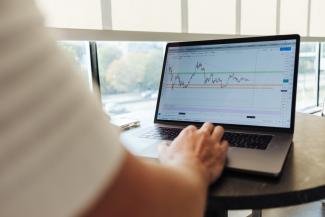
Seeing beyond short-term turmoil: Ideas for stock investors
This is not 2008
Volatility never feels good, but the foundation underlying it is important. Daily market moves in response to the COVID-19 outbreak have matched the scale of those seen during the global financial crisis. But this is not 2008. The coronavirus shock is not one caused by a crisis in the core of the financial system and spreading to the rest of the economy. The economy is on much stronger footing and the financial system is much more robust. In fact, policy measures and safeguards put in place since 2008 have only strengthened the financial system.
What to do? The bad news: Few investors are good at trading around extreme market volatility. The good news Decades of stock market history tell us “this too shall pass.” This, and our own experience, suggests that the most prudent tack for a long-term investor is to stay the course ― and to prepare for the opportunities that may arise as markets emerge from the turmoil.
Prepare now for opportunities ahead
- Quality cyclical stocks. Stocks with large market exposure (or “beta”) have under-performed our expectations. We see potential for these high-beta cyclicals to lead on the way back up. We would be discerning here and focus on those companies with high-quality balance sheets and the free cash flow to allow operational flexibility in market downturns.
- Value. Stocks of all stripes have declined, but value has been particularly hard hit. It has been the worst performing style factor year-to-date, lagging momentum, min vol and quality in both the early-year rally and in the subsequent sell-off. We see a short-term performance gap to be made up after a particularly sharp fall. History has taught us that value’s best times are generally rising out of a recession.
- Health care. The sector has held up better than the broad market since the downturn began on Feb. 19. The MSCI Health Care Index was down nearly 22% through March 16 versus an S&P 500 decline of roughly 29%. This is what we would have expected given the sector’s defensive characteristics and limited reliance on the economic cycle. We continue to like health care for its history of resilience, and see election-related fears subsiding as the Democratic nomination nears closure.
- U.S. stocks. No region has been spared amid the recent rout. Yet we see several reasons to stick with U.S. stocks over other developed markets: The U.S. has a diverse economy, as well as the nimbleness and tools to deploy further monetary and new fiscal stimulus. We also see a particularly good mix of valuation and quality among U.S. companies.
- One to avoid: leverage. Stocks with high debt ratios have under-performed in the downturn. While we would expect levered stocks to lead in a recovery, we would steer clear. If the slump is longer and more persistent than we expect, companies like these could suffer bankruptcy, resulting in a significant impairment to investor capital.
This information is provided for informational purposes only and does not constitute an offer or solicitation to buy or sell any securities discussed. It does not take into account the investment objectives, financial situation or specific needs of any particular client of IG. Before making an investment decision on the basis of any information contained in this article, the recipient should consider whether such information is appropriate given the recipient’s particular investment needs, objectives and financial circumstances. IG suggests that, prior to acting on any information contained herein, you contact one of our client advisers in your jurisdiction to discuss your particular circumstances. Since the levels and bases of taxation can change, any reference in this report to the impact of taxation should not be construed as offering tax advice; as with any transaction having potential tax implications, clients should consult with their own tax advisors. Past performance is not a guarantee of future results. The information and any statistical data contained herein were obtained from sources that we believe to be reliable, but we do not represent that they are accurate or complete, and they should not be relied upon as such. All estimates and opinions expressed herein constitute judgments as of the date of this report and are subject to change without notice. This document may provide addresses of, or contain hyperlinks to, Internet web sites. IG has not reviewed the linked Internet web site of any third party and takes no responsibility for the contents thereof. Each such address or hyperlink is provided solely for the recipient’s convenience and information, and the content of linked third-party web sites is not in any way incorporated into this document. Recipients who choose to access such third-party web sites or follow such hyperlinks do so at their own risk.
